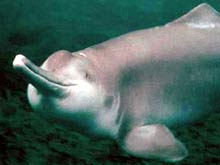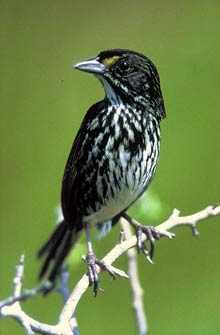
November 26, 2008
Optimism is good when it releases a surge of energy for redoubled efforts. In the fight to save a critically endangered species, it’s crucial to avoid the natural human tendency to be galvanized by fear but to relax when happy.
To keep that front and center, read the epitaphs of two species that didn’t make it because efforts to save them were too little, too late. Like the vaquita, neither of these species was hunted to the cliff-edge of extinction. What all three have in common is restriction to a very narrow and specific habitat, making them exquisitely vulnerable to human activities.
Bye-bye Baiji?
The Yangtze River dolphin (Lipotes vexillifer) was the world’s most endangered cetacean species. The vaquita has inherited that dubious honor because the baiji is apparently gone... or very nearly so.
The fate of the delicate dolphin is attributed to the destruction of their habitat, illegal fishing and collisions with ships. Regarded in China as the “goddess of the Yangtze”, the 20 million year old river dolphin was one of the world’s oldest species. The Baiji is the first large mammal brought to extinction as a result of human destruction to their natural habitat and resources.

In the beginning of the 1980s the Yangtze still had around 400 Baiji cavorting in its waters. However, the river dolphin became a victim of China’s rapidly growing economy.
Declared “functionally extinct”—a designation that’s not quite final—after a 2006 expedition failed to find a single animal, the baiji was reportedly sighted once in 2007. However, it takes at least two to begin again. The baiji’s shocking fate has galvanized efforts on behalf of the vaquita.
Nightfall for the Dusky
Just now, while fact checking a forthcoming (February) “This Land” column on the Merritt Island National Wildlife Refuge—also known as the John F. Kennedy Space Center!—I came across the grievous story of the dusky seaside sparrow (Ammodramus maritimus nigrescens), placed on the very first Endangered Species List [PDF], in vain. Surrounding destruction of its salt-marsh habitat [PDF] by fire, flood, and drainage overwhelmed the attempt to create refuges. The very last known dusky died in captivity on June 16, 1987. The story told in brief here [PDF, see p. 5] is drawn from the book-length elegy A Shadow and a Song, by Mark Jerome Walters.
“This wise and careful book is about two things. First, one small and engaging part of God’s creation, the dusky seaside sparrow. Second, our desire for ‘development,’ for vacation homes without mosquitoes, for ducks to hunt, and even for a trip to the moon. The bird is no more, but thanks to Mark Walters it leaves behind a powerful testimony.”




(Annie Gottlieb) |
Comments (add yours!)

Return to November home
|



